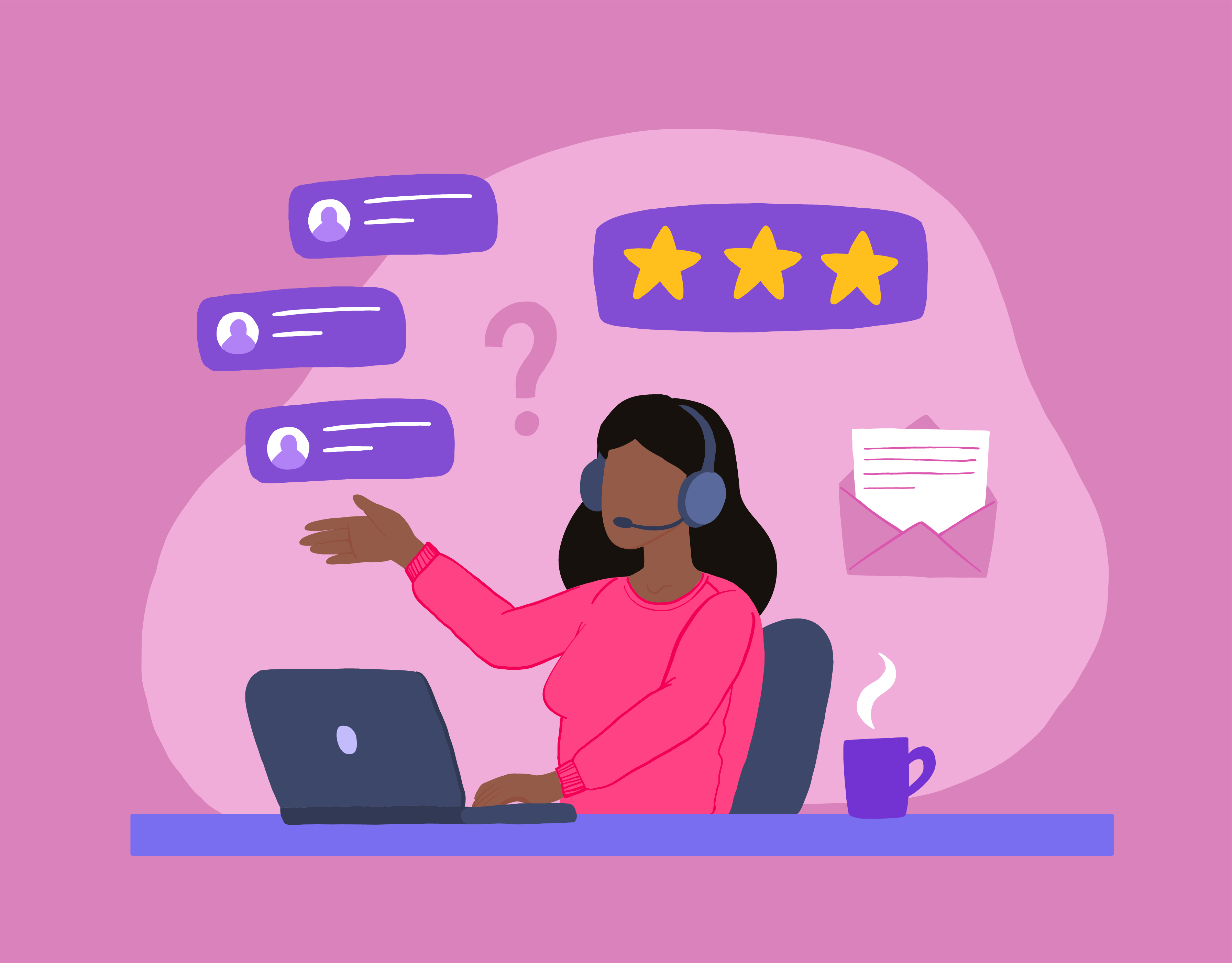Featured
Multi-Contact Handling: The Complete Guide
by Shaundalee Carvalho | Published On November 21, 2022 | Last Updated December 20, 2024

Enabling multi-contact handling in your contact center can be a great way to quickly boost your contact center’s service capacity without investing any extra funds, installing extra software, or hiring more agents.
Enabling multi-contact handling ultimately increases agent efficiency, which can lead to increases in profitability, customer satisfaction, and customer loyalty. Read on to learn more about multi-contact handling and how it can benefit your organization.
What is Multi-Contact Handling?
Multi-Contact Handling (MCH) is a contact center feature that allows users to handle multiple contacts at the same time.
What Communication Channels Are Eligible for Multi-Contact Handling?
When multi-contact handling is enabled, users can handle multiple conversations at the same time. However, this doesn’t apply to all channels. In particular, the nature of voice calls makes it impossible to handle multiple voice calls at the same time. However, users may handle multiple instant message (IM) or email conversations at the same time, or they may handle one or multiple IMs or emails while on a single voice call.
Additionally, when using ice Contact Center, other text-based channels are handled in the same way as instant messages and emails, meaning that they too are eligible for multi-contact handling. These channels include SMS and social media.
Learn more about the different communication channels offered by ice Contact Center and their eligibility for multi-contact handling below:
Voice
Voice is the channel most traditionally associated with contact centers. It involves an agent and a caller having a live, verbal conversation over the phone. Agents cannot handle multiple voice conversations at once, but they can handle one or more text-based interactions while handling a single voice conversation. This may not always be feasible, as voice calls tend to require more focus to provide a great customer experience. We therefore generally recommend sticking to a single conversation while on a voice call.
The email channel allows emails sent to your organization to be queued and handled by agents in your contact center. Multi-contact handling applies to emails, meaning that agents can handle multiple emails at the same time. This may be useful when, for example, an agent has asked a customer a clarification question by email and want to provide support to another customer while waiting for a response from the first.
Webchat/Instant Messages (IM)
The IM channel allows agents to exchange written messages with chatters in real time when chatters initiate a conversation via the chat window on the organization’s website. IMs are eligible for multi-contact handling, meaning that agents may carry on separate IM conversations with multiple chatters simultaneously. Agents can respond to one customer while waiting for a response from another.
SMS
The SMS channel allows customers to reach out using SMS messages via their cell phone carrier’s network. On the agent side, the messages appear the same way that instant messages do and are handled by agents in the same manner. Therefore, SMS messages are eligible for multi-contact handling as well.
Social Media Messages
A social media integration allows customers to reach out to an organization via a social media platform. These messages are delivered to agents through the contact center. Like SMS messages, they appear to agents like IMs and are handled the same way. Social media messages are eligible for multi-contact handling.
How Many Contacts Can an Agent Handle at Once?
Limits on how many contacts each user can handle at the same time may be set individually in the contact center’s administration tool. This means that each agent’s capacity will be aligned with their skill level and experience.
Additionally, even those agents set to handle more contacts can use their contact center toolbar to prevent themselves from receiving any more contacts if they’re dealing with a particularly involved interaction that requires more dedicated focus.
How to Enable Multi-Contact Handling
In ice Contact Center, multi-contact handling can be enabled in iceAdministrator. Allow Multi Contact Handling is a class of service setting that can be set for each user. Additionally, maximum concurrent IMs (or SMS or social media messages) and maximum concurrent emails can be set in iceAdministrator. Follow the steps below to enable multi-contact handling for a user:
- Open iceAdministrator in Edit mode. Note that you must have the correct permissions to edit user settings.
- Navigate to the user who you wish to enable MCH for.
- Click on the Class of Service tab in the user’s Properties page on the right side of the iceAdministrator window.
- Check the Allow Multi Contact Handling class of service. Additionally, enter the maximum concurrent IMs and maximum concurrent emails desired for the specified user.
- Click Save from the File menu.
Why Should You Use Multi-Contact Handling?
Multi-contact handling offers multiple benefits for agents, customers, and organizations. Read on to learn about some of them:
Reduce Wait Times
When an agent has MCH enabled, they can respond to one customer while waiting for a response from another customer. This means they can help multiple people in the time it would otherwise take them to complete a single conversation with one person. With this ability comes faster service and shorter wait times for customers.
Increase Customer Satisfaction and Loyalty
The efficiency improvements and reductions in wait times that result from multi-contact handling help to improve customer experiences. Positive customer experiences result in high customer satisfaction, which ultimately leads to improved customer loyalty and higher customer lifetime value.
Keep Agents Engaged
MCH allows agents to take on as many simultaneous interactions as they are comfortable with. This means they don’t have to wait around for customers to respond, feeling bored or underutilized. This keeps them engaged and ensures that they feel like they’re reaching their maximum potential.
Provide Agents with Motivation and Clear Progress Markers
Increases in agents’ contact handling capacity give them measurable goals to work towards and clear markers of progress. For example, a new agent may only be able to handle one contact at a time but strive to handle three or four like their more experienced colleagues; they will know they’re making progress when they feel ready to handle two at a time and so on.
Save Money
Enabling MCH is one of the simplest and most cost-effective ways to increase your organization’s contact handling capacity. For an organization looking to add capacity to their contact center, most options have costs associated with them – hiring more agents, investing in artificial intelligence or other efficiency-improving software, etc. Enabling MCH, on the other hand, is a simple change in settings, that involves little more investment than a few extra minutes of training. With this change, organizations can save on hiring and/or software.
Try Multi-Contact Handling Today
If you aren’t already using Multi-Contact Handling, now is the time to start. For more tips on improving efficiency, check out 3 Ways to Improve Efficiency in Your Contact Center. If you’re interested in enabling multi-contact handling in your ice Contact Center, reach out to your account representative or contact us today.
More from our blog
 This year, Ignite returned to Chicago for the first time since 2015, and that meant an even bigger venue, more days of content, and much better pizza!
This year, Ignite returned to Chicago for the first time since 2015, and that meant an even bigger venue, more days of content, and much better pizza!
 ComputerTalk can be described as a 35-year-old start-up, characterized by its dynamic environment and reliance on fresh graduates. My journey with ComputerTalk began as an enthusiastic new graduate eager to embark on my career. Now, approaching my third year, I...
ComputerTalk can be described as a 35-year-old start-up, characterized by its dynamic environment and reliance on fresh graduates. My journey with ComputerTalk began as an enthusiastic new graduate eager to embark on my career. Now, approaching my third year, I...
 In today’s dynamic landscape where customer expectations are constantly evolving and technological advancements like AI are reshaping how businesses operate, the contact center space stands at the forefront of this transformation. As customer preferences are shifting, organizations are looking to...
In today’s dynamic landscape where customer expectations are constantly evolving and technological advancements like AI are reshaping how businesses operate, the contact center space stands at the forefront of this transformation. As customer preferences are shifting, organizations are looking to...

